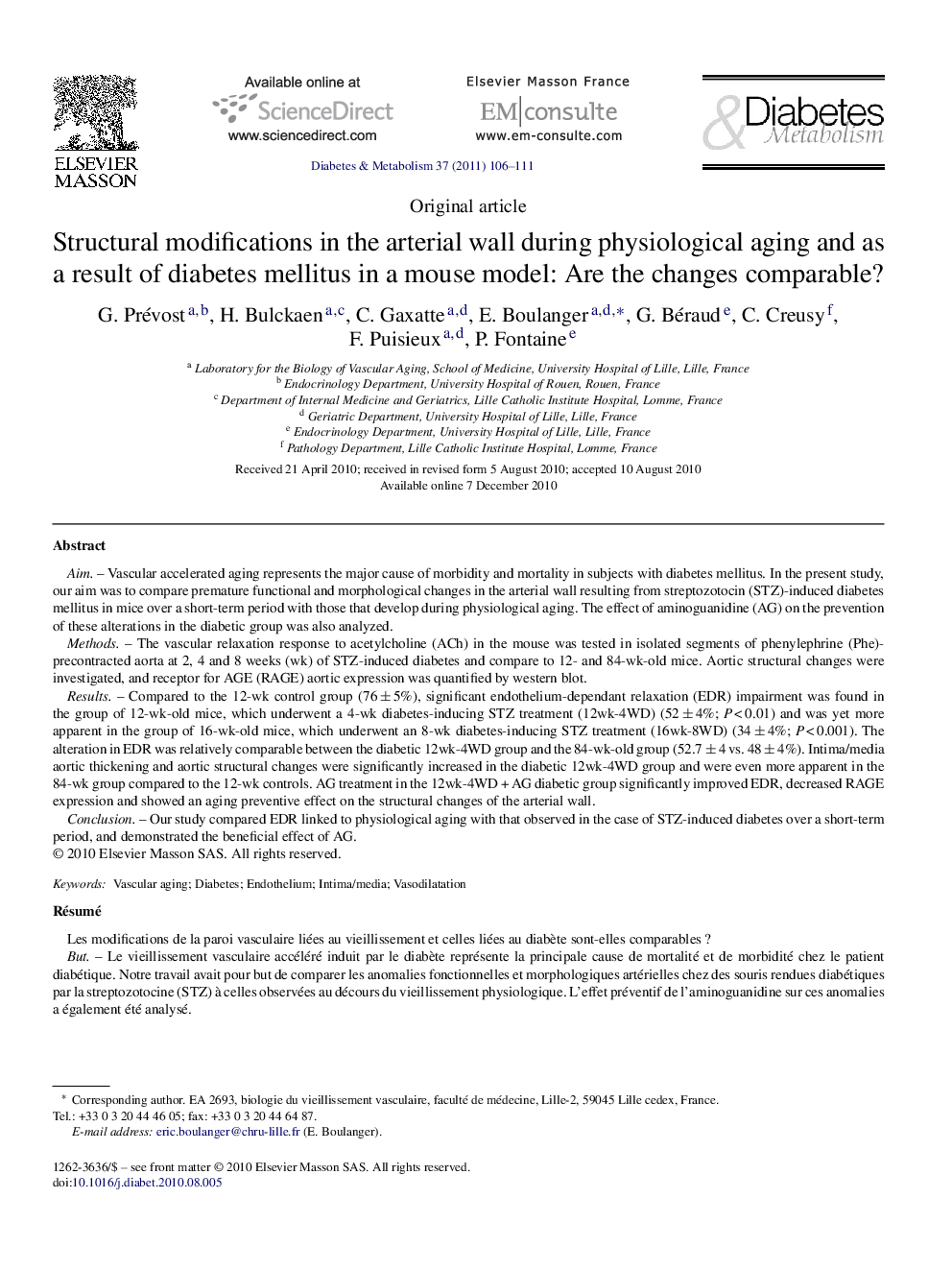| Article ID | Journal | Published Year | Pages | File Type |
|---|---|---|---|---|
| 3259893 | Diabetes & Metabolism | 2011 | 6 Pages |
AimVascular accelerated aging represents the major cause of morbidity and mortality in subjects with diabetes mellitus. In the present study, our aim was to compare premature functional and morphological changes in the arterial wall resulting from streptozotocin (STZ)-induced diabetes mellitus in mice over a short-term period with those that develop during physiological aging. The effect of aminoguanidine (AG) on the prevention of these alterations in the diabetic group was also analyzed.MethodsThe vascular relaxation response to acetylcholine (ACh) in the mouse was tested in isolated segments of phenylephrine (Phe)-precontracted aorta at 2, 4 and 8 weeks (wk) of STZ-induced diabetes and compare to 12- and 84-wk-old mice. Aortic structural changes were investigated, and receptor for AGE (RAGE) aortic expression was quantified by western blot.ResultsCompared to the 12-wk control group (76 ± 5%), significant endothelium-dependant relaxation (EDR) impairment was found in the group of 12-wk-old mice, which underwent a 4-wk diabetes-inducing STZ treatment (12wk-4WD) (52 ± 4%; P < 0.01) and was yet more apparent in the group of 16-wk-old mice, which underwent an 8-wk diabetes-inducing STZ treatment (16wk-8WD) (34 ± 4%; P < 0.001). The alteration in EDR was relatively comparable between the diabetic 12wk-4WD group and the 84-wk-old group (52.7 ± 4 vs. 48 ± 4%). Intima/media aortic thickening and aortic structural changes were significantly increased in the diabetic 12wk-4WD group and were even more apparent in the 84-wk group compared to the 12-wk controls. AG treatment in the 12wk-4WD + AG diabetic group significantly improved EDR, decreased RAGE expression and showed an aging preventive effect on the structural changes of the arterial wall.ConclusionOur study compared EDR linked to physiological aging with that observed in the case of STZ-induced diabetes over a short-term period, and demonstrated the beneficial effect of AG.
RésuméButLe vieillissement vasculaire accéléré induit par le diabète représente la principale cause de mortalité et de morbidité chez le patient diabétique. Notre travail avait pour but de comparer les anomalies fonctionnelles et morphologiques artérielles chez des souris rendues diabétiques par la streptozotocine (STZ) à celles observées au décours du vieillissement physiologique. L’effet préventif de l’aminoguanidine sur ces anomalies a également été analysé.MéthodesL’analyse de la vasorelaxation induite par l’acétylcholine a été testée sur des anneaux aortiques précontractés à la phényléphrine issus de souris âgées après deux, quatre et huit semaines de diabète, et issues de souris âgées de 12 et 84 semaines. Les modifications morphologiques aortiques ont été évaluées parallèlement et l’expression du récepteur des produits de glycation avancée (RAGE) au niveau aortique a été quantifiée par western blot.RésultatsComparativement aux souris témoins âgées de 12 semaines (12 s) (76 ± 5 %), la relaxation endothélium dépendante (endothelium-dependant relaxation [EDR]) était significativement diminuée chez les souris après quatre semaines de diabète (12 s, 4SD) (52 ± 4 % ; P < 0,01) et dans le groupe huit semaines de diabète(16 s, 8SD) (34 ± 4 % ; P < 0,001). Les anomalies d’EDR étaient comparables entre ces souris (12 s, 4SD) et celles observées chez des souris âgées de 84 semaines (52,7 ± 4 vs 48 ± 4 %). L’épaisseur intima/média et les modifications morphologiques étaient significativement augmentées chez les souris (12 s, 4SD) et plus encore chez les souris âgées de 84 semaines par rapport aux souris témoins (12 s). Le traitement par aminoguanidine des souris diabétiques âgées de quatre semaines a amélioré les anomalies d’EDR, diminué la surexpression de RAGE et prévenu partiellement l’apparition des modifications morphologiques.ConclusionNotre étude a comparé les anomalies EDR liées à l’âge et celles liées à un diabète induit par la STZ chez la souris et suggère un effet bénéfique de l’aminoguanidine dans la prévention de ces anomalies.
